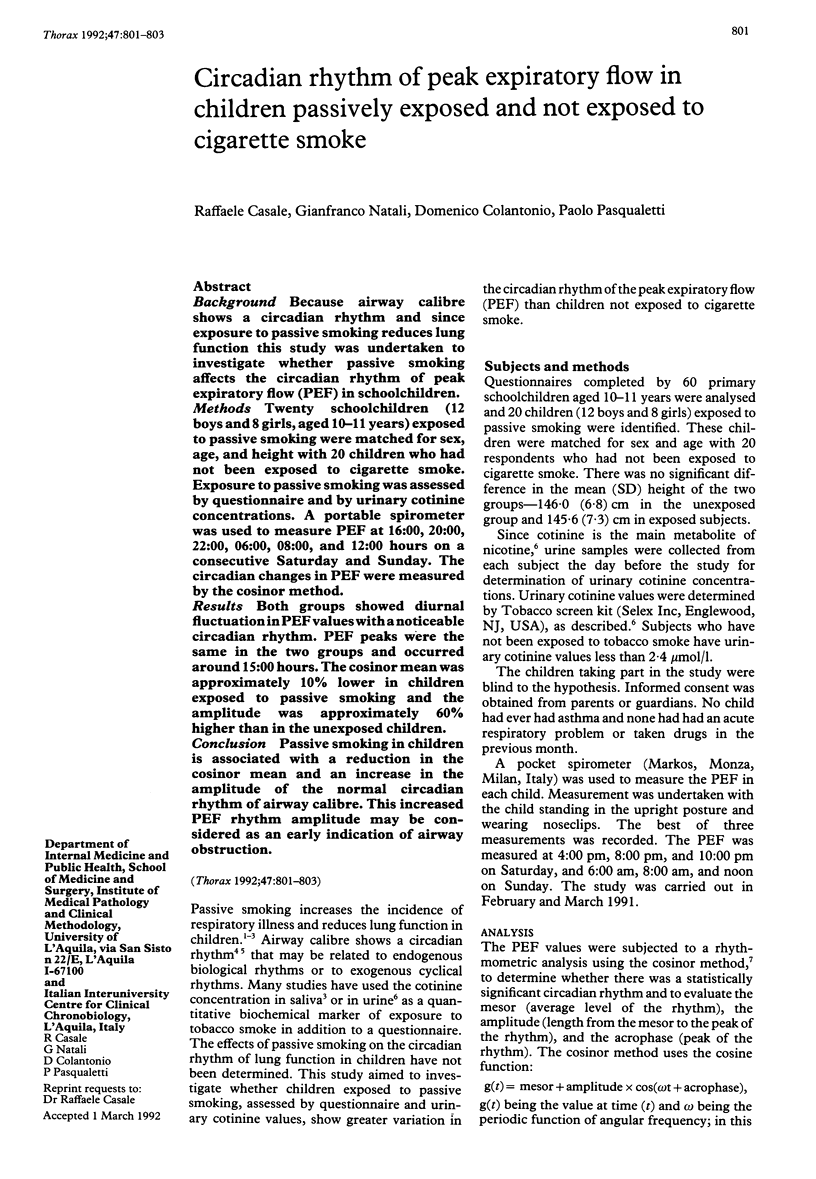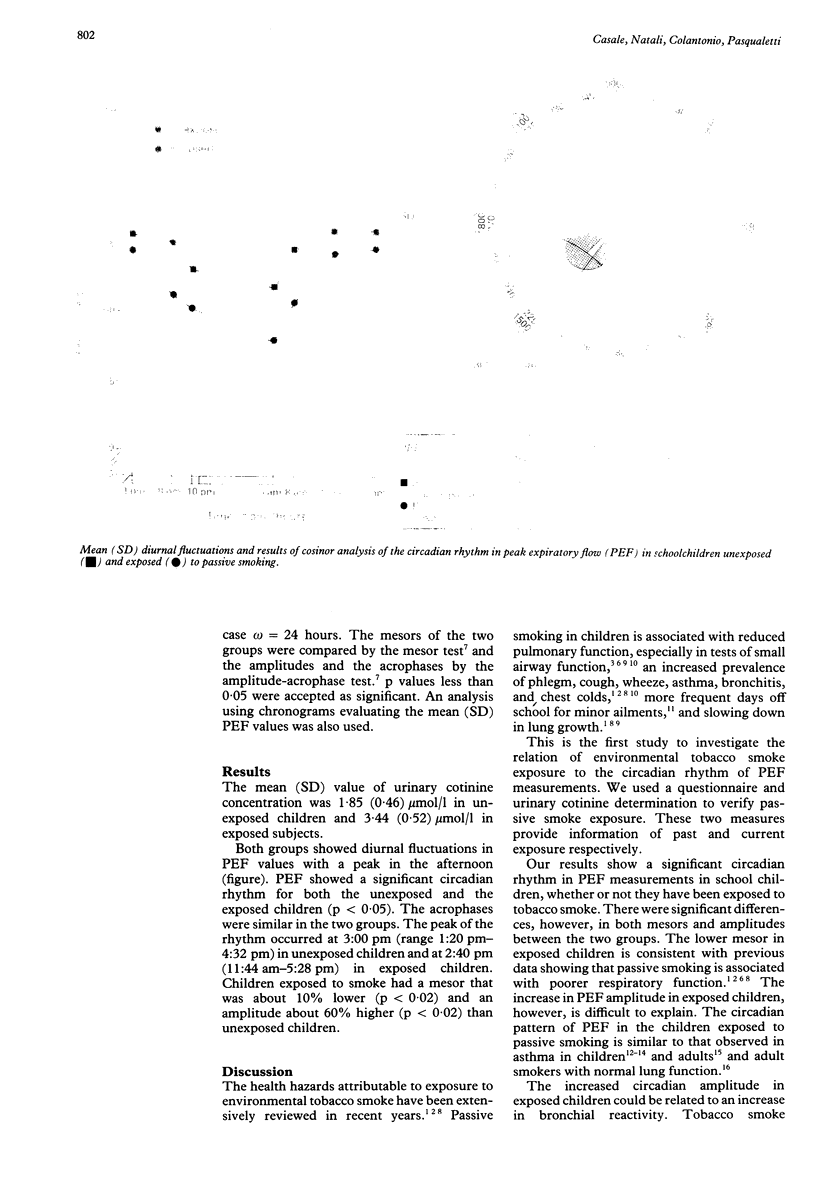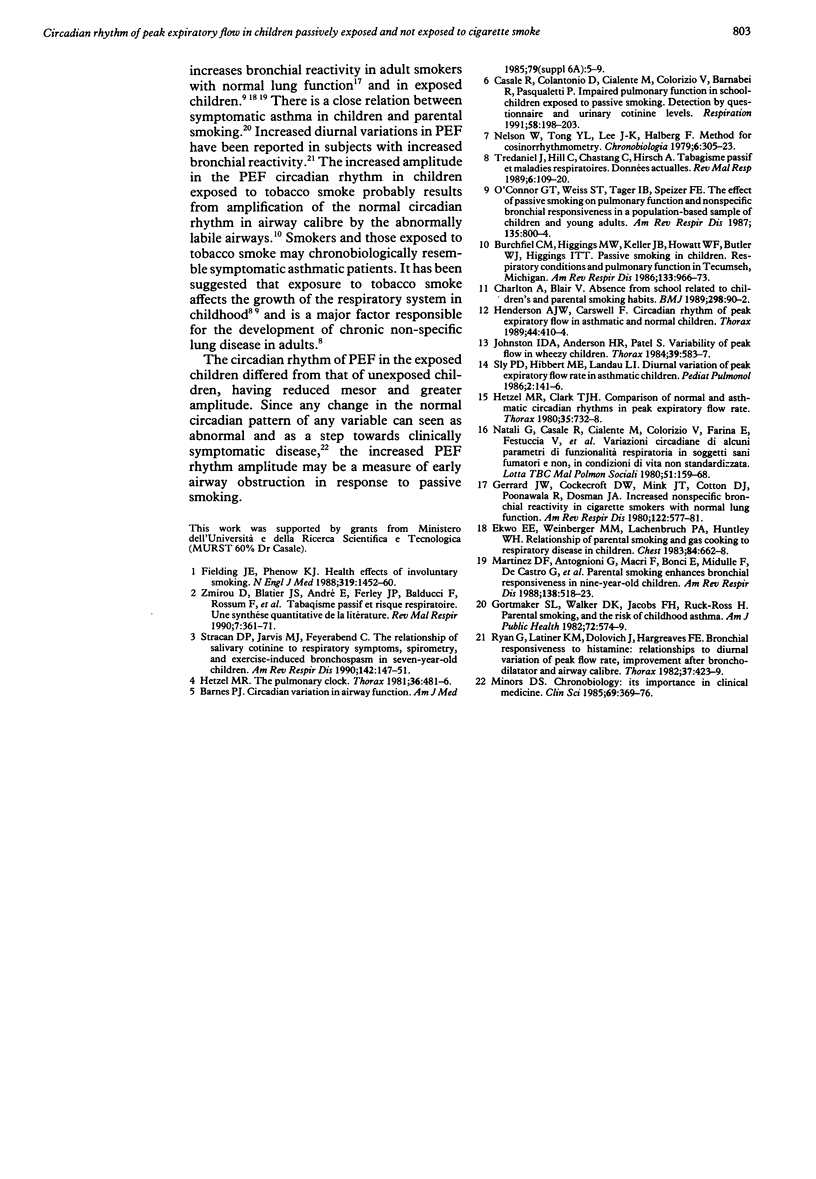Abstract
BACKGROUND: Because airway calibre shows a circadian rhythm and since exposure to passive smoking reduced lung function this study was undertaken to investigate whether passive smoking affects the circadian rhythm of peak expiratory flow (PEF) in schoolchildren. METHODS: Twenty schoolchildren (12 boys and 8 girls, aged 10-11 years) exposed to passive smoking were matched for sex, age, and height with 20 children who had not been exposed to cigarette smoke. Exposure to passive smoking was assessed by questionnaire and by urinary cotinine concentrations. A portable spirometer was used to measure PEF at 16:00, 20:00, 22:00, 06:00, 08:00, and 12:00 hours on a consecutive Saturday and Sunday. The circadian changes in PEF were measured by the cosinor method. RESULTS: Both groups showed diurnal fluctuation in PEF values with a noticeable circadian rhythm. PEF peaks were the same in the two groups and occurred around 15:00 hours. The cosinor mean was approximately 10% lower in children exposed to passive smoking and the amplitude was approximately 60% higher than in the unexposed children. CONCLUSION: Passive smoking in children is associated with a reduction in the cosinor mean and an increase in the amplitude of the normal circadian rhythm of airway calibre. This increased PEF rhythm amplitude may be considered as an early indication of airway obstruction.
Full text
PDF


Images in this article
Selected References
These references are in PubMed. This may not be the complete list of references from this article.
- Barnes P. J. Circadian variation in airway function. Am J Med. 1985 Dec 20;79(6A):5–9. doi: 10.1016/0002-9343(85)90080-4. [DOI] [PubMed] [Google Scholar]
- Burchfiel C. M., Higgins M. W., Keller J. B., Howatt W. F., Butler W. J., Higgins I. T. Passive smoking in childhood. Respiratory conditions and pulmonary function in Tecumseh, Michigan. Am Rev Respir Dis. 1986 Jun;133(6):966–973. doi: 10.1164/arrd.1986.133.6.966. [DOI] [PubMed] [Google Scholar]
- Casale R., Colantonio D., Cialente M., Colorizio V., Barnabei R., Pasqualetti P. Impaired pulmonary function in schoolchildren exposed to passive smoking. Detection by questionnaire and urinary cotinine levels. Respiration. 1991;58(3-4):198–203. doi: 10.1159/000195926. [DOI] [PubMed] [Google Scholar]
- Charlton A., Blair V. Absence from school related to children's and parental smoking habits. BMJ. 1989 Jan 14;298(6666):90–92. doi: 10.1136/bmj.298.6666.90. [DOI] [PMC free article] [PubMed] [Google Scholar]
- Ekwo E. E., Weinberger M. M., Lachenbruch P. A., Huntley W. H. Relationship of parental smoking and gas cooking to respiratory disease in children. Chest. 1983 Dec;84(6):662–668. doi: 10.1378/chest.84.6.662. [DOI] [PubMed] [Google Scholar]
- Fielding J. E., Phenow K. J. Health effects of involuntary smoking. N Engl J Med. 1988 Dec 1;319(22):1452–1460. doi: 10.1056/NEJM198812013192205. [DOI] [PubMed] [Google Scholar]
- Gerrard J. W., Cockcroft D. W., Mink J. T., Cotton D. J., Poonawala R., Dosman J. A. Increased nonspecific bronchial reactivity in cigarette smokers with normal lung function. Am Rev Respir Dis. 1980 Oct;122(4):577–581. doi: 10.1164/arrd.1980.122.4.577. [DOI] [PubMed] [Google Scholar]
- Gortmaker S. L., Walker D. K., Jacobs F. H., Ruch-Ross H. Parental smoking and the risk of childhood asthma. Am J Public Health. 1982 Jun;72(6):574–579. doi: 10.2105/ajph.72.6.574. [DOI] [PMC free article] [PubMed] [Google Scholar]
- Henderson A. J., Carswell F. Circadian rhythm of peak expiratory flow in asthmatic and normal children. Thorax. 1989 May;44(5):410–414. doi: 10.1136/thx.44.5.410. [DOI] [PMC free article] [PubMed] [Google Scholar]
- Hetzel M. R., Clark T. J. Comparison of normal and asthmatic circadian rhythms in peak expiratory flow rate. Thorax. 1980 Oct;35(10):732–738. doi: 10.1136/thx.35.10.732. [DOI] [PMC free article] [PubMed] [Google Scholar]
- Hetzel M. R. The pulmonary clock. Thorax. 1981 Jul;36(7):481–486. doi: 10.1136/thx.36.7.481. [DOI] [PMC free article] [PubMed] [Google Scholar]
- Johnston I., Anderson H. R., Patel S. Variability of peak flow in wheezy children. Thorax. 1984 Aug;39(8):583–587. doi: 10.1136/thx.39.8.583. [DOI] [PMC free article] [PubMed] [Google Scholar]
- Martinez F. D., Antognoni G., Macri F., Bonci E., Midulla F., De Castro G., Ronchetti R. Parental smoking enhances bronchial responsiveness in nine-year-old children. Am Rev Respir Dis. 1988 Sep;138(3):518–523. doi: 10.1164/ajrccm/138.3.518. [DOI] [PubMed] [Google Scholar]
- Minors D. S. Chronobiology: its importance in clinical medicine. Clin Sci (Lond) 1985 Oct;69(4):369–376. doi: 10.1042/cs0690369. [DOI] [PubMed] [Google Scholar]
- Nelson W., Tong Y. L., Lee J. K., Halberg F. Methods for cosinor-rhythmometry. Chronobiologia. 1979 Oct-Dec;6(4):305–323. [PubMed] [Google Scholar]
- O'Connor G. T., Weiss S. T., Tager I. B., Speizer F. E. The effect of passive smoking on pulmonary function and nonspecific bronchial responsiveness in a population-based sample of children and young adults. Am Rev Respir Dis. 1987 Apr;135(4):800–804. doi: 10.1164/arrd.1987.135.4.800. [DOI] [PubMed] [Google Scholar]
- Ryan G., Latimer K. M., Dolovich J., Hargreave F. E. Bronchial responsiveness to histamine: relationship to diurnal variation of peak flow rate, improvement after bronchodilator, and airway calibre. Thorax. 1982 Jun;37(6):423–429. doi: 10.1136/thx.37.6.423. [DOI] [PMC free article] [PubMed] [Google Scholar]
- Sly P. D., Hibbert M. E., Landau L. I. Diurnal variation of peak expiratory flow rate in asthmatic children. Pediatr Pulmonol. 1986 May-Jun;2(3):141–146. doi: 10.1002/ppul.1950020305. [DOI] [PubMed] [Google Scholar]
- Strachan D. P., Jarvis M. J., Feyerabend C. The relationship of salivary cotinine to respiratory symptoms, spirometry, and exercise-induced bronchospasm in seven-year-old children. Am Rev Respir Dis. 1990 Jul;142(1):147–151. doi: 10.1164/ajrccm/142.1.147. [DOI] [PubMed] [Google Scholar]
- Tredaniel J., Hill C., Chastang C., Hirsch A. Tabagisme passif et maladies respiratoires. Données actuelles. Rev Mal Respir. 1989;6(2):109–120. [PubMed] [Google Scholar]
- Zmirou D., Blatier J. F., André E., Ferley J. P., Balducci F., Rossum F., Delormas P. Tabagisme passif et risque respiratoire. Une synthèse quantitative de la littérature. Rev Mal Respir. 1990;7(4):361–371. [PubMed] [Google Scholar]



